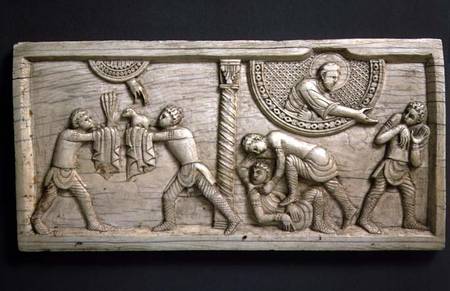
 Do I need to remind you this Friday is the Fourth of July? Many of us Americans will be celebrating our country's birthday by hitting the road for a three-day weekend. Packing a terrific book is crucial, and do I have a few sure-fire reads for you!
Do I need to remind you this Friday is the Fourth of July? Many of us Americans will be celebrating our country's birthday by hitting the road for a three-day weekend. Packing a terrific book is crucial, and do I have a few sure-fire reads for you! Let's begin with the trip itself. We'll assume you're traveling with an adult companion. To pass the time, you could jointly tackle one of those impossible British cryptic crossword puzzles. If that attempt fizzles, and your conversation falters, fuel it with a controversy. Note I said "fuel," not "use flamethrower." Keep in mind that topics such as "your no-good cousin, the one we have to keep bailing out of jail" or "your rotten taste in men that always gets you in trouble" could ruin the trip before you reach the destination. A better choice for a delectable bone of contention is provided by Rolling Stone's 500 Greatest Albums of All Time, edited by Joe Levy and published by Wenner Books in 2005. Where would you rank albums by Elvis Presley, the Stones, the Beatles, Bob Dylan, Chuck Berry?
Let's begin with the trip itself. We'll assume you're traveling with an adult companion. To pass the time, you could jointly tackle one of those impossible British cryptic crossword puzzles. If that attempt fizzles, and your conversation falters, fuel it with a controversy. Note I said "fuel," not "use flamethrower." Keep in mind that topics such as "your no-good cousin, the one we have to keep bailing out of jail" or "your rotten taste in men that always gets you in trouble" could ruin the trip before you reach the destination. A better choice for a delectable bone of contention is provided by Rolling Stone's 500 Greatest Albums of All Time, edited by Joe Levy and published by Wenner Books in 2005. Where would you rank albums by Elvis Presley, the Stones, the Beatles, Bob Dylan, Chuck Berry? Maybe you and your travel mate would rather sing songs instead of merely talk about them (hopefully, you're belting out lyrics in your car and not on my Southwest flight to Portland, Oregon). Take along Reading Lyrics, edited by Robert Gottlieb and Robert Kimball. It covers more than 1,000 lyrics, by more than 100 American and British song writers, from 1900 to 1975. It's a book you can use once you reach your destination, too. Hand it to your significant other while you slip into the shower. He or she can sit braced against the shower door and feed you lyrics. The two of you can warble a duet à la Natalie Cole and her father, Nat King Cole, with "Unforgettable."
Maybe you and your travel mate would rather sing songs instead of merely talk about them (hopefully, you're belting out lyrics in your car and not on my Southwest flight to Portland, Oregon). Take along Reading Lyrics, edited by Robert Gottlieb and Robert Kimball. It covers more than 1,000 lyrics, by more than 100 American and British song writers, from 1900 to 1975. It's a book you can use once you reach your destination, too. Hand it to your significant other while you slip into the shower. He or she can sit braced against the shower door and feed you lyrics. The two of you can warble a duet à la Natalie Cole and her father, Nat King Cole, with "Unforgettable." Alternatively, loll in the tub with mai tais and accompany lyrics from the musical South Pacific with rhythmic splashing and drumming toes. Create some personal fireworks and then towel off to "People Will Say We're in Love" from the Broadway hit Oklahoma!. Or, commemorate American independence with a bathtub reenactment of the Boston Tea Party (Twinings English Breakfast tea would be ideal here) and a spirited rendition of "The Star Spangled Banner." (Note: This last suggestion is open to suitable modification. If you're an American in the tub with a Brit, this scenario will work well; if your tub mate is French, pay tribute to Lafayette, the aristocratic French general who fought on the Americans' side in the Revolutionary War, with beaucoup toasts of champagne. If you're sharing the tub with a fellow American of the opposite political party, display patriotism as currently practiced in the United States by trying to drown each other.)
Alternatively, loll in the tub with mai tais and accompany lyrics from the musical South Pacific with rhythmic splashing and drumming toes. Create some personal fireworks and then towel off to "People Will Say We're in Love" from the Broadway hit Oklahoma!. Or, commemorate American independence with a bathtub reenactment of the Boston Tea Party (Twinings English Breakfast tea would be ideal here) and a spirited rendition of "The Star Spangled Banner." (Note: This last suggestion is open to suitable modification. If you're an American in the tub with a Brit, this scenario will work well; if your tub mate is French, pay tribute to Lafayette, the aristocratic French general who fought on the Americans' side in the Revolutionary War, with beaucoup toasts of champagne. If you're sharing the tub with a fellow American of the opposite political party, display patriotism as currently practiced in the United States by trying to drown each other.)If you're alone in the tub, there's no better place to begin Terry Hayes's I Am Pilgrim (Emily Bestler Books/Atria, May 27, 2014), which opens with a brilliant forensics expert, whom we come to know as Scott Murdoch (aka the Pilgrim), prowling around a squalid Manhattan hotel room, while an unidentifiable young woman lies in a bathtub full of acid. She appears to be the victim of a perfect, albeit gruesome, murder, but the roles she, the killer, and NYPD homicide detective Ben Bradley play in the multi-layered plot will only fully be revealed much later in this book of 600+ pages.
Meanwhile, we weave in and out of a jumble of Scott's troubled memories of people and places, piecing together his relationship with his folks, his recruitment into espionage by the Division, and his duties as a federal agent policing American spies in Europe and Asia before 9/11. Scott has barely taken early retirement when he is asked to investigate evidence of a terrorist plot found in Afghanistan. There is plenty of foreshadowing, but we readers are already following the separate story thread of a determined jihadi, codenamed "the Saracen," as he witnesses his father's beheading in Saudi Arabia, moves with his stricken mother and sisters to Bahrain, and forms the belief that the way to strike back at Saudi rulers is through their enablers in the West. It's a fascinating to and fro, watching Saracen's unfolding plot and Pilgrim's attempts to identify and stop him.
By the time we reach the ticking-clock finale, we've visited many locations, watched ingenious maneuvering and deductions, and met a host of complex characters. We may not be rooting for Saracen, but we understand him. The book could have used some trimming, and there are some exceedingly grisly scenes. But this first in an anticipated trilogy by Hayes, a movie screenwriter and producer of Payback and Mad Max Beyond Thunderdome, is a highly entertaining espionage thriller I was reluctant to put down.
 Speaking of highly entertaining, let me tell you about Lenny Kleinfeld's wild and witty Some Dead Genius (Niaux-Noir Books, May 30, 2014), which forced me to repeatedly put the book down, squeeze my eyes shut, clamp my lips closed, and re-route laughter through my nose out of courtesy to other people on the train.
Speaking of highly entertaining, let me tell you about Lenny Kleinfeld's wild and witty Some Dead Genius (Niaux-Noir Books, May 30, 2014), which forced me to repeatedly put the book down, squeeze my eyes shut, clamp my lips closed, and re-route laughter through my nose out of courtesy to other people on the train.This hardboiled black comedy involves a series of artists' murders investigated by the pair of smart, but cynical Chicago cops we first met in Shooters & Chasers (see review here): Mark Bergman, a 35-year-old hunk who goes through women like a dolphin goes through waves, and John "Doonie" Dunegan, a happily married family man. In Some Dead Genius, which can be read as a standalone, they're joined by a cast of colorful characters that includes mobsters, artists, politicians, and journalists. The book is R-rated for violence, sex, and language. Its structure allows a reader to tag along with the criminals, one of whom is so racked with guilt, I had to root for him; as well as watch Doonie and Mark chase the clues (I rooted for them, too). Chicago locations are put to good use; at one point, the cops pursue the killers through the Art Institute in an extended cinematic scene that could have been choreographed by Quentin Tarantino, had he channeled the Marx Brothers.
 I've been a Kleinfeld fan since the late Leighton Gage raved about him after judging books for the Best First Novel Edgar. Kleinfeld's fast-paced books are likely to appeal to fans of Elmore Leonard and Carl Hiaasen, but it's difficult to convey the high energy and originality of the prose without a sample, so here you go:
I've been a Kleinfeld fan since the late Leighton Gage raved about him after judging books for the Best First Novel Edgar. Kleinfeld's fast-paced books are likely to appeal to fans of Elmore Leonard and Carl Hiaasen, but it's difficult to convey the high energy and originality of the prose without a sample, so here you go:Tesca [a "semi-simian" loan shark] grabbed Dale's ear and dragged the squealing art dealer past forlorn walls pimpled with empty picture hooks, up a short set of stairs to a sleeping loft. Only thing in it was an air mattress, lost inside the imprint left by a king-size bed; Dale's furniture had marched out the door months ago. Tesca kicked the air mattress out of the way as he strode to the closet, with Dale's ear and what was attached to it lurching after him.Some Dead Genius would make a very fun vacation companion this weekend.
I'll be back on Thursday to tell you about a few more good weekend reads: Josh Malerman's Bird Box and Adam Brookes's Night Heron.
Note: I received a free advance review copy of Some Dead Genius from the author.








































